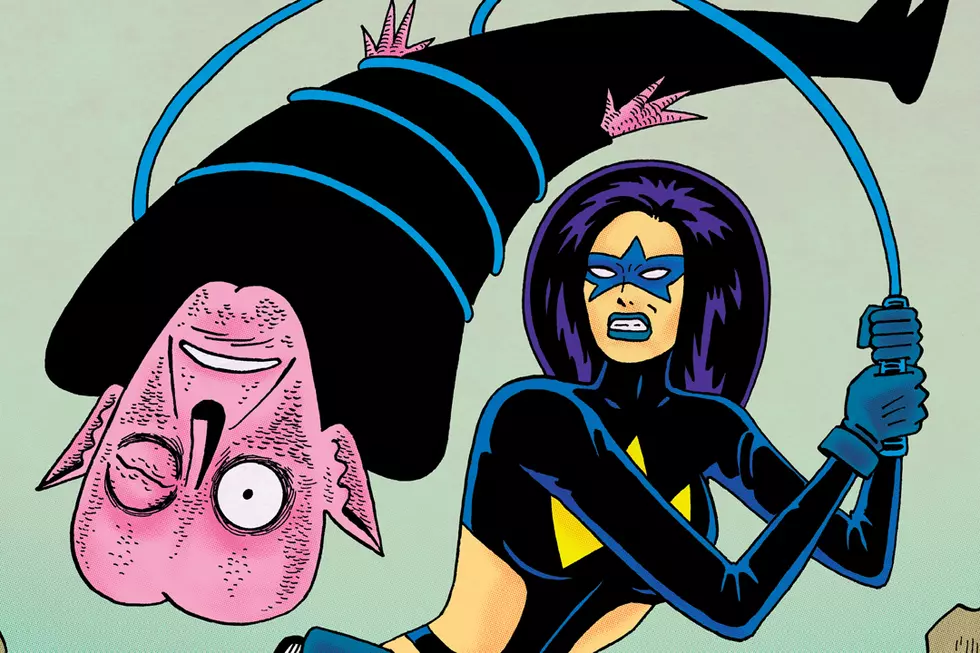
Thumbnail: Destroy This Comic!
Comics carry a sense of physical prestige. When you pick one up from the shelf, it usually isn’t just lying there, blowing in the wind – it’s often wrapped up in a too-tight plastic bag, boarded with a thin piece of cardboard to ensure you don’t crease a single hair on Superman’s immaculate head. The experience is designed to make you consider each comic as a precious item, something best kept mint so you can sell it and get your grandkids through college in a few decades from now.
The thing is, sometimes we need to be reminded that comics are not immaculate, and actually there’s no reason not to mess them up a little in the course of reading. Some of the most enjoyable moments in comics over the last few years have been those moment where the storytellers step back, wave an arm towards the story they’re telling, and say, “Hey, let’s take a pair of scissors to this, eh?”
One recent comic to jump at this was The Delinquents, by James Asmus, Fred Van Lente, and Kano, over at Valiant, which decided in the final issue that readers should cut up a fight scene and act it out themselves, rather than sit passively and read through a prescriptive sequence. It’s an act of defiance, because in order to cut something out, you have to essentially say to yourself, "Yep, never reading this again anyway," and throw the pieces in the bin afterwards. We've seen so many fight scenes over the years that, well, why not just let us do it ourselves?
When done badly, like when comics use a cut-out mask that is ultimately worthless to anyone without an A5-sized face, it can make the comic seem stupid. But when done well, it can lift the reader out of the passive reading process and reminds them to participate.
Punks does this within the comic itself, as artist Kody Chamberlain uses a knife to cut out photographs and pop art and forcibly embed them into his pages. The choice forces readers out of merely receiving the comic’s imagery and into responding to and questioning it.
The brilliant outrage raised by David Hine and Shaky Kane sums up the spirit of destruction shown in this artistic choice. In their inspired series Bulletproof Coffin: Disinterred they created an issue, cut each panel out individually, threw the panels into a pile and then rearranged them sight-unseen. The result is a crash of imagery and ideas that asks the reader to make their own story, and decide how the unrelated panels should actually relate to one another. No longer are you following a single story – you’re participating in creating a multiverse of your own.
In establishing this concept for readers, the pair actually create a disposable comic that outlasts almost any other. Not only is there the infinite story within the comic as presented to readers, but there’s also the opportunity for people to bring out the scissors themselves and assemble their own story from the published comic. Readers can form a comic that resembles the structure used by Hine and Kane, or set up twenty panel pages, one panel pages – they can revisit the stream of consciousness in whichever way they like.
The invitation to destroy your comic – to cut it apart, remove pieces and insert yourself into the narrative – can be the greatest offer of creation. Comics can sit pristine on the shelf for years, taped shut, never to be read again. Or they can go out in a shred of glory, torn up, ripped apart, and configured into a ragged, scrappy work of complete imagination. Something new, probably disposable, but ultimately everlasting.
More From ComicsAlliance
![The Silver Age Is In Full Swing In ‘Comic Book History Of Comics’ #5 [Preview]](http://townsquare.media/site/622/files/2017/03/CBH05-featured.jpg?w=980&q=75)
![‘Normandy Gold’ Digs Through The Underbelly Of ’70s Washington DC [Preview]](http://townsquare.media/site/622/files/2017/03/Normandy_Gold_1_Featured.jpg?w=980&q=75)
![Don’t Lose Your Head Over ‘Immortal Brothers: Tale Of The Green Knight’ [Preview]](http://townsquare.media/site/622/files/2017/03/GreenKnight01.jpg?w=980&q=75)
![Dan Slott And Stuart Immonen Bring Norman Osborn Back In ‘Amazing Spider-Man’ #25 [Preview]](http://townsquare.media/site/622/files/2017/02/ASM-Featured.png?w=980&q=75)
![The Unvarnished, Unpretty, Unchivalrous Truth: Fred Van Lente On ‘Immortal Brothers: The Tale Of The Green Knight’ [Interview]](http://townsquare.media/site/622/files/2017/01/ImmortalBros.jpg?w=980&q=75)

![Shadowman Returns In ‘Divinity III: Shadowman And The Battle Of New Stalingrad’ #1 [Preview]](http://townsquare.media/site/622/files/2017/01/Shadowman00.jpg?w=980&q=75)


